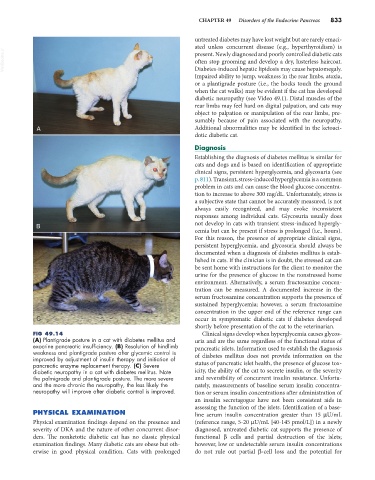Page 861 - Small Animal Internal Medicine, 6th Edition
P. 861
CHAPTER 49 Disorders of the Endocrine Pancreas 833
untreated diabetes may have lost weight but are rarely emaci-
ated unless concurrent disease (e.g., hyperthyroidism) is
VetBooks.ir present. Newly diagnosed and poorly controlled diabetic cats
often stop grooming and develop a dry, lusterless haircoat.
Diabetes-induced hepatic lipidosis may cause hepatomegaly.
Impaired ability to jump, weakness in the rear limbs, ataxia,
or a plantigrade posture (i.e., the hocks touch the ground
when the cat walks) may be evident if the cat has developed
diabetic neuropathy (see Video 49.1). Distal muscles of the
rear limbs may feel hard on digital palpation, and cats may
object to palpation or manipulation of the rear limbs, pre-
sumably because of pain associated with the neuropathy.
A Additional abnormalities may be identified in the ketoaci-
dotic diabetic cat.
Diagnosis
Establishing the diagnosis of diabetes mellitus is similar for
cats and dogs and is based on identification of appropriate
clinical signs, persistent hyperglycemia, and glycosuria (see
p. 811). Transient, stress-induced hyperglycemia is a common
problem in cats and can cause the blood glucose concentra-
tion to increase to above 300 mg/dL. Unfortunately, stress is
a subjective state that cannot be accurately measured, is not
always easily recognized, and may evoke inconsistent
responses among individual cats. Glycosuria usually does
B not develop in cats with transient stress-induced hypergly-
cemia but can be present if stress is prolonged (i.e., hours).
For this reason, the presence of appropriate clinical signs,
persistent hyperglycemia, and glycosuria should always be
documented when a diagnosis of diabetes mellitus is estab-
lished in cats. If the clinician is in doubt, the stressed cat can
be sent home with instructions for the client to monitor the
urine for the presence of glucose in the nonstressed home
environment. Alternatively, a serum fructosamine concen-
tration can be measured. A documented increase in the
serum fructosamine concentration supports the presence of
sustained hyperglycemia; however, a serum fructosamine
concentration in the upper end of the reference range can
C occur in symptomatic diabetic cats if diabetes developed
shortly before presentation of the cat to the veterinarian.
FIG 49.14 Clinical signs develop when hyperglycemia causes glycos-
(A) Plantigrade posture in a cat with diabetes mellitus and uria and are the same regardless of the functional status of
exocrine pancreatic insufficiency. (B) Resolution of hindlimb pancreatic islets. Information used to establish the diagnosis
weakness and plantigrade posture after glycemic control is of diabetes mellitus does not provide information on the
improved by adjustment of insulin therapy and initiation of
pancreatic enzyme replacement therapy. (C) Severe status of pancreatic islet health, the presence of glucose tox-
diabetic neuropathy in a cat with diabetes mellitus. Note icity, the ability of the cat to secrete insulin, or the severity
the palmigrade and plantigrade posture. The more severe and reversibility of concurrent insulin resistance. Unfortu-
and the more chronic the neuropathy, the less likely the nately, measurements of baseline serum insulin concentra-
neuropathy will improve after diabetic control is improved. tion or serum insulin concentrations after administration of
an insulin secretagogue have not been consistent aids in
assessing the function of the islets. Identification of a base-
PHYSICAL EXAMINATION line serum insulin concentration greater than 15 µU/mL
Physical examination findings depend on the presence and (reference range, 5-20 µU/mL [40-145 pmol/L]) in a newly
severity of DKA and the nature of other concurrent disor- diagnosed, untreated diabetic cat supports the presence of
ders. The nonketotic diabetic cat has no classic physical functional β cells and partial destruction of the islets;
examination findings. Many diabetic cats are obese but oth- however, low or undetectable serum insulin concentrations
erwise in good physical condition. Cats with prolonged do not rule out partial β-cell loss and the potential for

